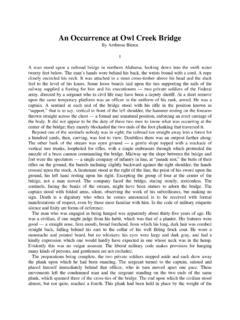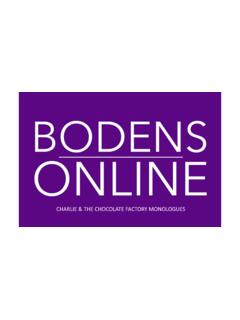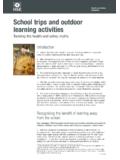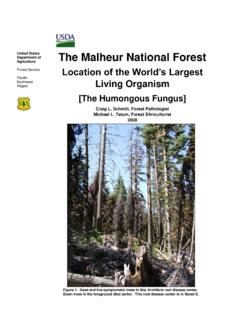Transcription of Big Four Construction Hazards: Struck-by Hazards
1 Big Four Construction Hazards : Struck-by HazardsThis material was produced under grant number SH-17792-08-60-F-48 Occupational Safety and Health Administration, Department of Labor. It does not necessarily reflect the views or policies of the Department of Labor, nor does mention of trade names, commercial products, or organizations imply endorsement by the following presentations have been developed in both Spanish and English for the Construction industry. These presentations focus on the Big Four Construction Hazards falls, electrocution, caught-in and training materials will cover the four Hazards seen regularly on Construction sites and will focus on the methods for the recognition and the prevention of these common Hazards Recognition1.
2 Struck-by Falling Objects2. Struck-by Flying Objects3. Struck-by Swinging/Slipping Objects4. Struck-by Objects on Ground Prevention1. Personal Protective Equipment2. Material Storage3. Proper Materials Handling4. Work Zone SafetyStruck-by Hazards Struck-by Hazards are one of the four most deadly Hazards found at Construction sites. This program will help you recognize common Struck-by Hazards . The symbol will tell you if the situation in the picture is either safe or not safeStruck-by Statistics Each year workers die from Struck-by accidents. During the year 2007: Total deaths from Struck-by cases: 504 Deaths in Construction .
3 311 Approximately 26% of deaths in Construction are from Struck-by accidents Approximately 10% of all occupational deaths are from Struck-by accidentsHazard Recognition Struck-by Hazards exist any time a worker could be struck or hit by an Falling Objects Working or walking below elevated work surfaces may expose you to falling Falling Objects Materials being moved overhead expose you to falling Falling Objects Keep a safe distance from suspended Falling Objects Store materials Flying Objects Power tools and activities such as pushing, pulling, or prying can create flying Flying Objects Grinding or striking materials can create flying object Flying Objects Air pressurized above 30 psi can drive oils and other particles through your Swinging/Slipping Objects Do not work under loads as they are being Swinging/Slipping Objects Secure all loads and lift them evenly to prevent them from Objects on Ground Level You may be struck by moving Objects on Ground Level Heavy equipment can create serious Struck-by Objects on Ground Level All traffic on Construction sites can create Struck-by Objects on Ground Level Workers in work zones are
4 Exposed to struck by Hazards from Construction equipment and motorist Objects on Ground Level Never work near vehicle traffic without You will be presented with a specific hazard recognition question to test your understanding of this 1 Struck-by Hazards cause only minor injuries andare not a big concern to Construction -True B -FalseQuestion 1 Struck-by Hazards cause only minor injuries andare not a big concern to Construction correct answer is:B -FalseQuestion 2A Struck-by hazard can be described as:A -Not wearing a seatbelt while driving a forkliftB -Anytime a worker has the potential to be struck or hitby an object C -Anytime a worker can get any part of his body caughtin or in between objectsD -Falling off a roofQuestion 2A Struck-by hazard can be described as:The correct answer is:B -Anytime a worker has the potential to bestruck or hit by an objectQuestion 3_____ is an example of a stuck-by hazard.
5 A -A spark from a grinder sets grass on fireB -A worker falls through a skylight C -A steel member is being flown to the next level andswings, hitting a worker D -A worker is crushed by an excavatorQuestion 3_____ is an example of a stuck-by hazard. The correct answer is:C -A steel member is being flown to the nextlevel and swings, hitting a workerQuestion 4 When working on interior jobs on constructionsites hardhats are not TrueB -FalseQuestion 4 When working on interior jobs on constructionsites hardhats are not correct answer is:B -FalseQuestion 5 When working near vehicles and equipment, youmust:A -Never place yourself between a vehicle and an immovable object such as a buildingB -Make eye contact with the operator before crossing the path of the vehicleC -Always watch for operators who may not be watching youD -All the aboveQuestion 5 When working near vehicles and equipment, youmust:The correct answer is:D -All the aboveAccident Prevention A willing, positive attitude towards safety will help make a safer work Prevention Plan your work and look for potential Hazards .
6 Each task will have different Protective Equipment (PPE) Wear a hard hat if overhead Hazards Protective Equipment (PPE) Wear safety glasses or a face shield if flying Hazards Protective Equipment (PPE) A highly visible reflective vest will allow motorists and equipment operators to see Storage Secure materials so they do not fall on Storage Maintain proper house-keeping in all storage Materials Handling Inspect all rigging before Materials Handling Never walk or work under a Materials Handling Never lift a load that is greater than the crane s lifting Zone Safety Use extreme caution when approaching heavy equipment.
7 Work Zone Safety Traffic work zones must be clearly marked to make motorists aware of the work ahead. Work Zone Safety Use physical barriers to protect workers from vehicle traffic. QUIZ You will be presented with a specific accident prevention question to test your understanding of this 1 Hardhats are the only personal protectiveequipment required on Construction TrueB -FalseQuestion 1 Hardhats are the only personal protectiveequipment required on Construction correct answer is:B -FalseQuestion 2On a Construction site you should store materials:A -Anyway you want toB -So they do not fallC -As high as you canD -Only on the roofQuestion 2On a Construction site you should store materials:The correct answer is.
8 B -So they do not fallQuestion 3 All rigging used to lift materials must be inspected:A DailyB -Before each useC MonthlyD -When you think about itQuestion 3 All rigging used to lift materials must be inspected:The correct answer is:B -Before each useQuestion 4To prevent materials from slipping when lifted,you should:A -Tightly secure themB -Lift the load evenlyC -Both A and BD -Neither A or BQuestion 4To prevent materials from slipping when lifted,you should:The correct answer is:C -Both A and BQuestion 5 Workers are exposed to what types of vehicletraffic in a work zone?A -Heavy equipment and motorist trafficB -Motorist trafficC -Heavy equipment trafficD -Air trafficQuestion 5 Workers are exposed to what types of vehicletraffic in a work zone?
9 The correct answer is:A -Heavy equipment and motorist trafficDisclaimer/Usage Notes Photosshowninthispresentationmaydepictsi tuationsthatarenotincompliancewithapplic ableOSHA requirements. Itisnottheintentofthecontentdevelopersto providecompliance-basedtraininginthispre sentation,theintentismoretoaddresshazard awarenessintheconstructionindustry,andto recognizetheoverlappinghazardspresentinm anyconstructionworkplaces. ItshouldNOTbeassumedthatthesuggestions,c omments,orrecommendationscontainedherein constituteathoroughreviewoftheapplicable standards,norshoulddiscussionof issues or concerns ( bestpractices )havebeenexpressed,itisimportanttorememb erthatsafetyissuesingeneralandconstructi onjobsitesspecificallywillrequireagreatd ealofsite-orhazard-specificity-a onesizefitsall approachisnotrecommended,norwillitlikely beveryeffective.
10 Itisassumedthatindividualsusingthisprese ntation,orcontent,toaugmenttheirtraining programswillbe qualified todoso,andthatsaidpresenterswillbeotherw isepreparedtoanswerquestions,solveproble ms, Notes Norepresentationismadeastothethoroughnes softhepresentation, ,andthatthedevelopersofthiscontentcannot beheldresponsibleforsafetyproblemstheydi dnotaddressorcouldnotanticipate, yourindividualStaterequirementsmaybemore stringent. Asapresenter,youshouldbepreparedtodiscus sallofthepotentialissues/concerns, FourConstruction Hazards : Struck-by HazardsThis concludes theStruck-by Hazards Module The End














